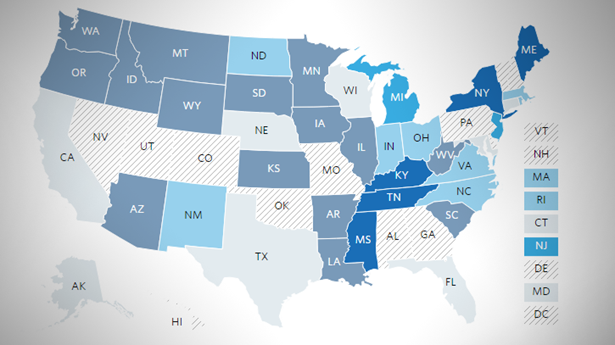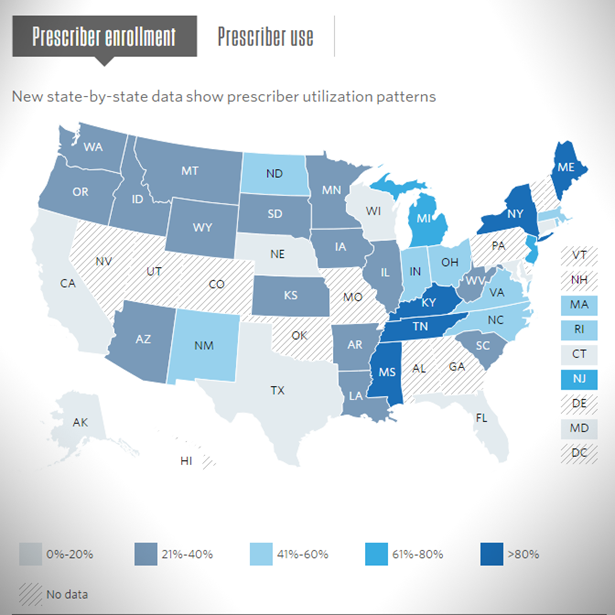How States Can Help Curb Opioid Misuse
Increasing prescriber use of prescription drug monitoring programs is critical to stopping the opioid crisis

A new report finds that states can increase prescriber use of PDMPs by adopting one or more of eight evidence-based practices.
© John Moore/Getty Images
As the opioid crisis continues to ravage communities across the United States, policymakers and public health officials are increasingly using new tools such as prescription drug monitoring programs (PDMPs)—state-based electronic databases that track the dispensing of certain controlled substances—to stem the misuse of prescription opioids and reduce overdose deaths.
PDMPs can be used to monitor patient use of these drugs and inform prescribing decisions. However, the number of prescribers actually using these databases in clinical care remains low.
A new report from The Pew Charitable Trusts and the Institute for Behavioral Health, Heller School for Social Policy and Management at Brandeis University finds that states can increase prescriber use of PDMPs by adopting one or more of eight evidence-based practices:
- Prescriber use mandates, or state laws and regulations that require prescribers to view a patient’s PDMP data under certain circumstances. Mandates can rapidly increase PDMP utilization and immediately affect prescriber behavior, which can help prevent “doctor shopping”—when patients seek the same or similar drugs from multiple prescribers and pharmacies in a short period.
- Delegate access, which allows prescribers to authorize someone on staff, such as a nurse or other member of the health care team, to access the PDMP data on their behalf. The majority of states allow delegate access; evidence suggests such access addresses workflow barriers and increases PDMP use.
- Unsolicited reports, where prescribers are proactively notified about patients who may be at risk for harm based on their controlled substance prescription history. These alerts can help increase prescriber use in two ways: by motivating them to review patient data and informing unenrolled prescribers about the existence of the PDMP.
- Improving data timeliness, or increasing the frequency at which data are uploaded into PDMP databases. Many states now require dispensers to upload new data on a daily basis, which increases the timeliness of information and encourages PDMP use.
- Streamlining enrollment by making it easier for prescribers and delegates to register with their state PDMPs. Enrollment is required before clinicians can check PDMP data, so making this process faster and easier can increase use.
- Educational and promotional initiatives that help prescribers understand how PDMPs work and encourage their use. Such activities can spur enrolled prescribers and delegates to check PDMP data and inform unenrolled clinicians about the value of these databases.
- Integrating PDMP data with health information technology, which helps prescribers seamlessly access PDMPs through electronic health records or other IT systems. Pilot projects across the country found that prescribers reported PDMP data were easier to access when the system was integrated into daily workflows.
- Enhancing PDMP user interfaces, or redesigning how data are presented, to help prescribers more quickly analyze prescribing information and make better-informed decisions.
Of the eight practices, mandates are the single most effective way to increase prescriber use. But a mandate alone does not mean that prescribers will use the PDMP effectively in clinical decision-making. Therefore, state officials should explore the other seven strategies and adopt a combination of practices that works best for their program. PDMPs can play a critical role in curbing prescription opioid misuse, but only if states take steps to ensure that the data are easy to access and understand.
Cynthia Reilly directs the substance use prevention and treatment initiative for The Pew Charitable Trusts and Sheri Lawal works on the program. Tom Clark is a research associate with the Institute for Behavioral Health, Heller School for Social Policy and Management at Brandeis University.


America’s Overdose Crisis
Sign up for our five-email course explaining the overdose crisis in America, the state of treatment access, and ways to improve care
Sign up

Prescription Drug Monitoring Programs
Evidence-based practices to optimize prescriber use.
Learn More

Mapping Prescription Drug Monitoring Program Enrollment and Use
State-by-state data show prescriber utilization patterns









